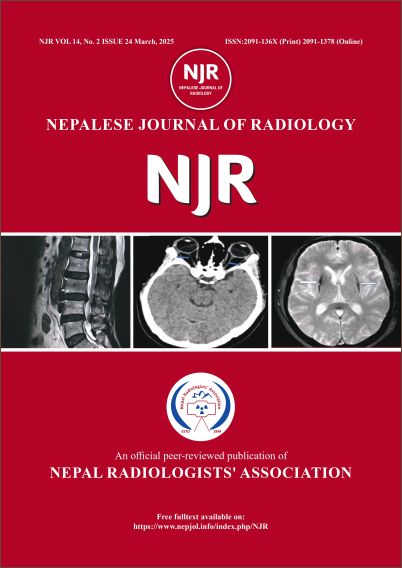Magnetic Resonance Imaging (MRI): Choice of Modality in Assessing Terminal End of the Spinal Cord “Conus Medullaris”
DOI:
https://doi.org/10.3126/njr.v14i2.75728Keywords:
Infant, Spinal Cord, Spinal Puncture, Vertebral BodyAbstract
Introduction: The lowermost tapering end of the spinal cord is called Conus Medullaris (CM). It is important to recognize the level of CM termination, especially during diagnostic procedures like lumbar puncture, or to rule out the cause of any lower back pain. Magnetic Resonance Imaging (MRI) gives near-accurate information on the structures. The main objective of this study was to determine the level of termination of the spinal cord and correlate it with the patient's age and gender.
Methods: A retrospective study was conducted in the Radiology and Imaging Department at Gandaki Medical College, Pokhara, Nepal, from June 1 to September 30, 2023. MRI sagittal T1 and T2 weighted spin echo sequences of the lumbar spine from 91 adults (18–80 years) were analyzed to determine the spinal cord termination location.
Results: The position of conus medullaris varied between the T12 vertebral body and the L3 vertebral body. The average position was found to be the L1 vertebra, 7.13 ± 1.985 in females and 7.02 ±1.621 in males, Frequency and median were at 7, which corresponds to the L1 vertebral body. Likewise, the mean level of CM was at 6.94 ± 1.697 in 18-28 years, 6.76 ± 1.662 in 29-39 years, 7.13±1.746 in 40-50 years, 7.63 ± 2.419 in 51-61years, 7.18 ± 1.601 in 62-72 years and 8 ± 0 in 73-83 years.
Conclusions: The conus medullaris was observed to terminate between the T12 and L3 vertebral bodies. No statistically significant correlation was found between the vertebral level of the conus medullaris and age
Downloads
Downloads
Published
How to Cite
Issue
Section
License
Copyright (c) 2025 Nepalese Journal of Radiology

This work is licensed under a Creative Commons Attribution-NonCommercial 4.0 International License.
This license enables reusers to distribute, remix, adapt, and build upon the material in any medium or format, so long as attribution is given to the creator. The license allows for commercial use.




